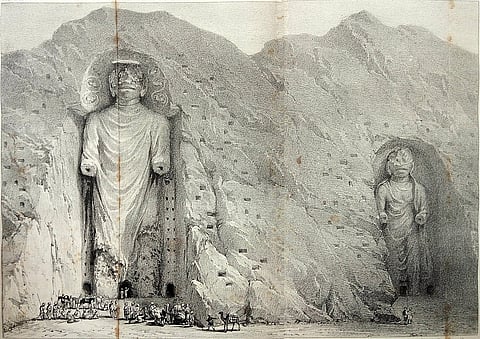- Commentary
- History Vignettes
- Notes on Culture
- Dispatches
- Podcasts
- Indian LanguagesIndian Languages
- Support

One of the first things that struck me when I was researching the forgotten Hindu history of Pakistan is this: beginning with the second century up to the eighth century CE, we have almost no primary sources to reconstruct the Hindu history of this region with any accuracy. That’s six hundred years of cruel, tragic silence. The inference is rather straightforward: throughout these six centuries, the Hindus in that region were involved first in a series of defensive battles against a determined and relentless enemy that respected no rules, had no scruples, and was fuelled by an unquenchable thirst for plunder which had both the sanction and inspiration of his imperialistic desert cult clothed in the garb of religion. Once the defences broke down as they're bound to in all such cases, it became a matter of mere survival. And once the Hindus had reached that stage, we get a much clearer picture of the history of the region: by the seventh or eighth century CE, northwestern India had stopped producing the best of the Sanatana genius. No more Paninis or Kautilyas would flourish there.
After the eighth century CE, the maximum primary sources of the history of this region which are still available, are written by Muslim chroniclers of that period. We all know how those histories read. Vincent Smith provides a glimpse into the mindset of these medieval Muslim chroniclers with naked contempt.
Despite these enormous losses, we’re stunned at the extraordinary resilience of the Sanatana spirit when we read the relatively recent history of this region: first the Marathas and later Maharaja Ranjit Singh, reconquered extensive territories including Peshawar and parts of Afghanistan after more than six hundred years--that is, in the mid-to-late 19th century CE.
We can look at this from another perspective provided by the ever-reliable Rishi, historian and scholar, Sita Ram Goel.
This then, is the other way to understand the different facets of the forgotten Hindu history of Pakistan. In our present age of our willing subjection to digital distraction, there are two quick methods to do this:
1. To notice the state of Hindu temples, and other monuments in Pakistan inspired by the fount of Sanatana Dharma. Their histories are available at least in an outline form. These accounts are truly eye-opening to say the least.
2. To read the list of UNESCO World Heritage sites in this region. When we read this list, we immediately notice the fact that most of them are located precisely in the areas where the Islamic conquest of Bharatavarsha occurred first. It is also noteworthy that Afghanistan has only two world heritage sites: the badly battered Bamiyan Buddhas being the only Santana-inspired heritage site.
And then, when we read the history of something as recent as the freedom struggle, it is common to see names like Sindh, Lahore, Karachi, Rawalpindi, Sialkot, Kohat etc in the same way that we today take the names of Bangalore, Mumbai, Bhopal, Delhi, Chandigarh, Chennai, etc. All these cities and towns now in Pakistan were also great centres of our freedom struggle against the British. For example, Lala Lajpat Rai, Rajguru, Bhagat Singh, and Sukhdev…all died in Lahore. The number of nationalist publications—newspapers, magazines, etc published from regions now in Pakistan is also significant. In those days, it was considered prestigious if a business house had branches in both Bombay and Karachi to which there was direct and unfettered sea access. Today, Karachi is in enemy territory. We can cite hundreds of such examples but the important point to remember is this: Islamabad did not exist before 1960. What does that tell us about the forgotten Hindu history of Pakistan?
Finally, there is a common sense reason and urgency to learn and keep the forgotten Hindu history of Pakistan in our active memory. It is understandable that Pakistan doesn’t teach the history of its Hindu past: it is due to the founding ideology and its state religion which treats the savage erasure of its Hindu past as a victory over a dark faith. However, it is both a civilisational necessity and imperative for what remains of Bharatavarsha to teach and remember always, the Hindu history of Pakistan.
Even in this case, the educational system of Pakistan itself shows us the way. There is an interesting academic report published in 2008-9 in Pakistan about the state of textbooks in Pakistan written by Pakistani academics. That report has an interesting data point about how…Chemistry is taught to children…Chemistry. Not history. Pakistani children are taught about the composition of Water in the following way: "Two atoms of Hydrogen and One atom of Oxygen come together, and by the grace of Allah, water is formed."
Unless we learn and remember this forgotten Hindu history of Pakistan, our kids, here, in India, sometime in the future, will have textbooks written like this.
Concluded
The Dharma Dispatch is now available on Telegram! For original and insightful narratives on Indian Culture and History, subscribe to us on Telegram.
